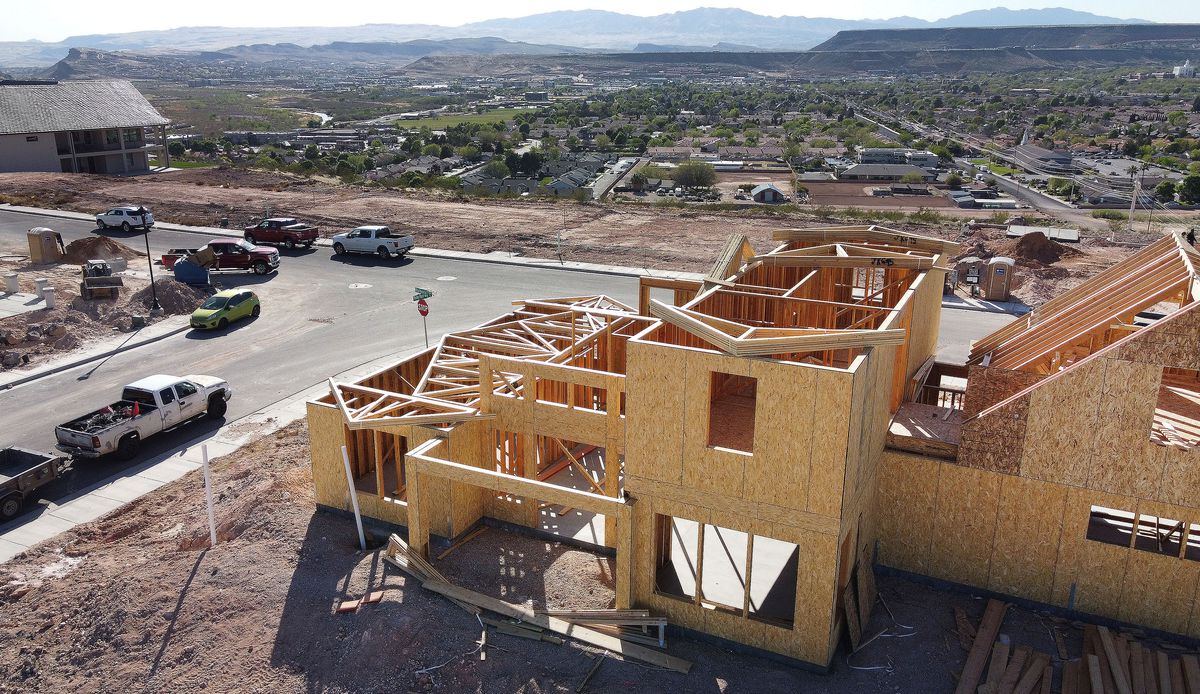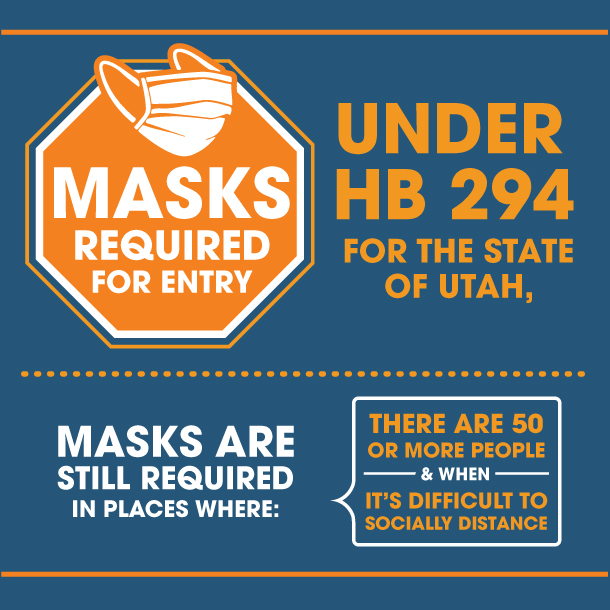Utah
Why is southern Utah like Disneyland? Despite long lines, high prices, people flock there
Published
4 years agoon
By Alicia Moore 
Editor

Utah – In one Utah city, there are just 200 homes for sale but 2,000 real estate agents as an exodus of out-of-staters and others who want to get into their first home battle for a space to call their own.
It’s not unlike the housing market throughout many communities in the Beehive State, where buyers often need to offer between $20,000 and $50,000 above asking price to even get their bid considered.
But the situation in St. George — a city nestled among red rocks sitting on the southwest edge of Utah — can be likened to Disneyland at spring break.
Long lines, inflated prices and fatigue, but people are willing to sweat it out to be there, a hop, skip and jump away from Zion National Park, Lake Powell and other attractions.
An estimated 50% or more of incoming residents hail from California and other states. They are lured to the area after the pandemic made remote work common “because although our cost of living and our house prices are rising, they’re still much lower than in California,” said Jordan Hess, vice president of member services and public policy for the St. George Area Chamber of Commerce.
City and business leaders say they’re trying to ensure the area keeps its explosive growth sustainable as the desert town grapples with water shortages and other infrastructure limitations.
‘It’s going to push younger families out of this area’
According to U.S. Census data, St. George had just under 73,000 people in 2010 and grew to nearly 90,000 with about 30,000 households by 2019.
Within the past six months, nearly 1,200 houses have sold with a median price of $420,558, according to a report by the Larkin Group real estate agency. Between 2015 and 2019, the median home value was $286,000, census data states.
The latest census numbers haven’t yet been released, but city leaders anticipate a resident count in the mid- to upper-90,000s, said Adam Lenhard, St. George city manager. But that estimate doesn’t include part-time residents, visitors and tourists, of which the city has many.
The Stevenses have been looking for a house since they got married last September. They receive new real estate listings each day, that is, of “the 12 that are available,” Tim Stevens said.
They’ve made a few offers. Most recently, Stevens asked a seller to call him to negotiate if Stevens’ offer was close to what he wanted, but before they could speak, Stevens learned the owner’s real estate agent had accepted a cash offer.
“I see a house go up for sale, and by the time I contact them later that day, in just a short time, within just a few days, the house has already been sold,” Stevens said.
“Or the house needs to be totally renovated and is not livable,” he said.
Dee Amick, president of the Washington County Board of Realtors and Realtor with ERA Brokers Consolidated, said the number of homes that appear on the area’s real estate listing service varies each day.
At the end of March, the number was 198, which Amick described as just a month’s worth of inventory. By comparison, last year before pandemic-related shutdowns started, the area had about 1,300 homes listed for sale, according to Amick.
Between two-thirds and three-fourths of the listings are usually single-family homes, while the rest include trailers, town houses and condos, Amick said.
And competition for those homes is intense as 1,650 real estate agents work primarily in Washington County, while another 350 work there part time, he said.
“It’s a challenge. It can be frustrating at times. I’ve talked to agents here recently who have written 10 to 15 offers on homes and haven’t been accepted because the demand is so great, and you can throw a house on the market, and you might get 20 offers on it,” he said.
The Stevenses started their marriage in an 800-square-foot casita without a range or washer and dryer. They’re thankful now to rent a single-family home from a friend but realize they need their own home to grow their family, and their time in their current rental home ends in September.
“We need the space so that we can have children, but we also need to be able to afford the space in which we live in order to provide a comfortable home for our children. Because if your mortgage payment is so ridiculously high that you can’t even afford to have children, then what’s the point in that?” Stevens said.
Like many, they also want to put their living costs toward the investment of a home rather than renting.
Many of the homes they’re finding in their price range “aren’t livable” and would need between $60,000-$100,000 in work. But a construction loan requires a 20% down payment, which the couple can’t afford.
“And for newlywed couples, that’s just not really conducive,” Stevens said.
He and his wife are both attending college full time even as he works a full-time job and she works part time. Without two full-time sources of income “it’s nearly impossible to have enough money to rent, save and be able to put a down payment on a property,” Stevens said.
He expressed frustration that people from out of town are partly responsible for pushing home prices higher and eventually “it’s going to put younger families out of this area because they don’t have the income sources to support that living situation and a mortgage,” Stevens said.
Builders struggling to keep up
Area home builders say they’re coping with delays caused by the pandemic.
The biggest issues are significant shortages of concrete, lumber, windows, plumbing fixtures, hardware and appliances, said Mari Krashowetz, executive officer of the Southern Utah Home Builders Association.
She called the lack of some products without prior notice the biggest cause for the slowdown in building.
“The simplest material in the supply chain, such as resin that is used to manufacture (oriented strand board) came from mostly one factory in Texas and they were shut down. The reason for the material shortages is due to COVID delays and the housing boom we are experiencing. We also have a labor shortage to compound the delays,” Krashowetz said.
To keep up with demand, builders have needed to pivot on some building products and order different, sometimes more expensive materials, she said.
“Some builders have to order materials from northern Utah. They arrange for the trucking and pay extra to get the materials here. Home prices have been increasing because of the material increases and labor shortage. Trade contractors have been working extra hours to try and keep up with demand,” Krashowetz said.
Many builders are now only selling completed homes, Krashowetz said.
“By doing this they can set the sales price based on actual costs and can avoid delays in delivering the home as promised at the time of sale. Other builders have made the decision to not keep waiting lists. Instead, they list a home and put it on the market so that it gives potential buyers the opportunity to put an offer in on the home,” she said.
In those instances, the offers are often “considerably higher” than list price, and the builder will choose the one that seems like the best fit, according to Krashowetz.
“This does not necessarily mean the highest price, sometimes it can simply be whomever seems like they will be easy to work with and the offer written up with the highest degree of professionalism,” she said.
Many are looking to existing homes due to the burden on builders.
Amick said he recently represented the seller of a 1,700-square-foot, three bedroom home. After listing the home on a Monday at 2:30 p.m., Amick said it had several offers within just a few hours. By the next day it had more than 20 offers and ultimately sold for “way over” asking price, he said.
While most are still seeing homes in person before making offers, some are buying sight unseen. One of Amick’s clients, who needed to move for business, “knew what would happen if she didn’t make an offer and take a chance, and so she did unseen, and we actually got it under contract. They accepted our offer,” he said.
Real estate agents are also seeing an influx of people whose jobs went remote during the pandemic moving to southern Utah from California, according to Amick.
“Why work in a city maybe where the property taxes are high and it’s crowded, when they come here and you have more open space, their taxes are lower, and in my opinion it’s much prettier,” Amick said.
He estimated the average length of time it takes buyers to find homes in southern Utah at two months. Some who bid high above asking price can get their first offer accepted, while others can make 10 offers and get rejected each time.
The market is also creating struggles for single professionals.
Allie Roundy, a 26-year-old graphic artist who works for one of the area’s largest employers, said she’s been looking for a home to purchase over the past year. In the meantime, she moved in with her parents in St. George.
“And it’s obviously not the best situation for people right now who are single and young,” she said.
Roundy has been working for a few years and wants a place of her own, which she could potentially share with roommates, but she’s noted an extreme shortage of town houses and other houses in her price range.
Single adults don’t have double income, “so to try to find something that is in your price range, there’s just nothing,” she said.
Roundy noted that many people coming into jobs at Tech Ridge — which St. George has hoped will become like the fast-growing technology sector mecca Silicon Slopes along the Wasatch Front — won’t be able to find places to live.
It’s an issue of supply and demand, Amick said. Eventually, the market will likely return to balance, he just doesn’t know when.
“Hopefully when we get a lot more people back to work from COVID, and maybe we can get materials back on track and the demand is being met by those as far as building, then the building can catch up, and that will help to alleviate some of this,” Amick said.Despite tension in the housing market, business and city leaders say the growth is a good thing.
Infrastructure concerns
It’s not the first time the city has experienced such a boom. In the mid- to late-2000s, St. George also saw a large jump in construction.
Stopping the growth, as some residents have historically called for, would have “significant unintended consequences,” Lenhard said.
“It would even further reduce the housing supply, and the only thing that happens in a scenario like that is the housing prices just go up even more. So that would be a very undesirable outcome, and there’s not really a feasible scenario where the growth stops. And that’s not healthy for an economy or a community. Communities that are not growing, there are typically many consequences to that that you don’t want as a community,” Lenhard said.
Along with growth comes the need to hire city staff to take care of things like parks, roads, water and sewer lines, and electrical infrastructure. But Lenhard says officials have sought to take a conservative approach in staffing so as not to pass on cost or tax increases to residents. The city now employs 1,200 people, 740 of whom work full time.
But in some areas, the city is behind due to the growth rate, Lenhard said, explaining that leaders recognize a “significant need” for public safety expansion and are working to address it. The city recently opened a new 911 dispatch center, which handles calls for the whole county. A new fire station is also slated to be built this year, with two more in the near future.
“The growth and the increasing population brings with it all new amenities, stores, restaurants, shopping opportunities, all of those great things that we love. It also brings traffic congestion and air pollution. So those are all the things we look to mitigate, and things that are also a part of a growing community, and that provides an ongoing challenge for us at the city to manage that as best we can,” Lenhard said.
To offset traffic impacts, several projects are underway or planned that will expand major roads — meaning that now, traffic congestion is an issue. Lenhard noted the difficulty in planning roads due to St. George’s natural topography and landscape of mesas, ridges and bluffs.
“We don’t have the flexibility to put roads and infrastructure in the places where we might want them the most, or where it might be the most convenient,” he said. “It makes our planning a little more nuanced.”
According to Lenhard, the unique geography also serves as a natural barrier to growth. “We are growing quickly, but we can’t grow forever at this pace,” he said.
The area also has finite water resources and available land. Much of the land within St. George’s boundaries is protected and will never get developed.
The city has developed some of its own water supply through wells and water rights that it can draw from, and it is also under the Washington County Water Conservation District.
While St. George has some flexibility and sufficient capacity for current needs, Lenhard said, officials are trying to look out into the long term, recognizing that water is one of the most valuable resources in southern Utah.
“And we have to be very careful in our use and make sure that we’re always leaving enough for the future, and that we’ve left ourselves enough of a cushion to get through prolonged droughts like the one we’re in,” he said.
St. George officials will release a new general plan this year, marking the first comprehensive change since 2006.
“It’s a huge process, and we hope that our residents will take the opportunity to participate in that,” Lenhard said.
Growth brings an economic diversification that benefits the community, Hess said. Historically, the city has focused on tourism, but the tech industry continues to expand and new restaurants keep cropping up.
“We want our economy to continue to strengthen, we want it to be a desirable location,” Hess said.
“I think it’s finding the balance of not growing too quickly, but also striking that right balance where the ordinances and regulations aren’t getting in the way of people wanting to build their home or relocate their business here,” he said.
Businesses moving in
The rapid growth has also led to a shortage of workers “across the board,” said Hess, with the St. George Area Chamber of Commerce.
“I’ve had just in the past week, two or three of our chamber members approach me saying that they need help finding employees. And what we’re seeing is that there are lots of jobs available, and we just need to match the employees with the employers because the market is so tight,” Hess said.
One of those businesses, a bakery named Farmstead, opened just over two weeks ago and has already needed to hire more workers due to demand, Hess said.
Chris Connors, bakery owner, said he and his wife had been looking for an excuse to move to St. George from Henderson, Nevada, and COVID-19 gave them the opportunity. They loved southern Utah for its nature, and education cuts in Henderson led the family to seek a more conducive environment for their 4-year-old and a 2-year-old.
At first, Farmstead opened with 15 workers. But the community has responded to the European-style bakery, of which there were few — if any — in the area before, Connors said.
“And it looks like we’ll be closer to 20 by the end of this week. We added a couple bakers, a couple of cashiers, a dishwasher, things like that. And I might have to hire a couple more, too, depending on how production is,” Connors said.The unemployment rate stands at about 3% in the area, but the fast population increase means new businesses and the need for employees to staff them, Hess said.
While nearly every industry now faces difficulty finding employees, Hess said the need is acute in construction due to the number of people moving in. It’s difficult to find the construction workforce necessary to “keep up” with demand.
While the tourism and hospitality community suffered during the pandemic, things are picking up again. Washington City has seen a 21% increase in sales tax, Hess said.
“And so, to me, what that says, is people from California and Nevada are coming and visiting our area, and so we need the workforce and we need the help,” he said.
While he believes the workers are out there in the community, Hess says the difficulty lies in matching employees with jobs. The chamber often receives phone calls from businesses seeking personal assistants or line cooks, and they don’t know where to find them because the labor market is tight, Hess said.
Connors said it’s been “a little bit challenging” for him to find workers, and has sought to bring new workers into the restaurant through word of mouth.
In Las Vegas, where he and his wife own other restaurants, many people have hospitality industry experience due to the volume of hotels and restaurants.
“You kind of get more experience for people in Las Vegas, but at the same time, St. George is kind of changing when it comes to that, because it is becoming a nice hospitality hub. And hiring qualified candidates is always difficult any way you cut it,” he said.
But he said he’s so far found a great workforce and expressed optimism for his family’s future in the area.
“It’s just a beautiful place, I feel, to raise children. There’s a ton of parks. We haven’t had one negative experience here and I love it. I’m so happy we moved here,” Connors said.




